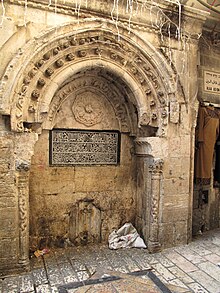Sabil an-Nazir
The Sabil an-Nazir ( Arabic سبيل الناظر, DMG Sabil an-Nazir ) is an Ottoman fountain in the old city of Jerusalem .
Surname
The name in Arabic سبيل الناظر, DMG Sabil an-Nazir (also: Arabic سبيل باب الناظر, DMG Sabil Bab an-Nazir and Arabic سبيل طريق باب الناظر, DMG Sabil Tariq Bab an-Nazir ) carries the fountain because it is near the council gate ⊙ Arabic باب الناظر Bab an-Nazir 'Inspector's Gate, Council Gate' and in the street Arabic طريق باب الناظر, DMG Tariq Bab an-Nazir (also: Ala 'e-Din street) is located. Another name of the fountain is Arabic سبيل الحرم, DMG Sabil al-Haram 'Well of Haram'. It is derived from the fact that it is located on Ala 'e-Din Street, which leads to the Council Gate through which Muslims can access the Haram ⊙ .
geography
The Sabil an-Nazir ⊙ is located in the Muslim Quarter of Jerusalem . It is located 90 m west of the Council Gate on the north side of Ala 'e-Din Street on the corner of Ala' e-Din Street and Al Wad .
description
The sable is framed by a rectangular frame. This frame protrudes from the surrounding wall, in the west by 1 m in the east by 0.88 m. This difference arose from a small change in the direction of the road. The frame is 3.53 m wide and 3.89 m high. A profiled bead forms the edge of the frame .
An almost round arch is inserted in the center of the frame. It surrounds a recessed niche that is 1.81 m wide and 0.55 m deep. Its height including the arch is 3.43 m, up to the base of the arch 1.86 m. A profiled bead forms the outer edge of the arch.
The arch rises from two fighters who rest on rectangular stone pillars. The fighters consist of five small muqarnas with foliage ornaments.
The outer arch is decorated with a keel arch and two ribbons with foliage. The upper band shows foliage and flowers. The lower band shows a number of small rosettes.
The inner arch is a bulge, which is also decorated with small rosettes.
The field in the arch is decorated with a large medallion , in the middle of which there is a small rosette from which eight rays emanate. There is an inscription underneath.
Further down, surrounded by a small, shallow niche, there is a hole from which the water used to come out. Below was a pool that has been lost or is below street level.
The outer and inner edges of the two rectangular pillars on which the arch rests are decorated with round pillars with a cable pattern.
Existing elements from the time of the Crusaders were used to design the fountain . This was done on the one hand out of respect and appreciation for the architecture of this past time, on the other hand for reasons of cost savings. Only the muqarnas that support the arch on both sides date from the Ottoman period.
inscription
The inscription:
“He ordered the construction of this blessed Sabil, our master, the Sultan, the greatest prince and the honorable Hakan who rules the nations, the Sultan of the countries of Rum , the Arabs and Persians, the Sultan Suleyman , the son of the Sultan Selim Khan May Allah maintain and continue his rule and sultanate on the 2nd of Ramadan in the year 943 (February 12th 1537). "
Water supply
The well was supplied with water from a cistern behind it and via the Qanat as-Sabil and its branches.
history
A waqfiyya (deed of foundation) preserved in the Sijills of Jerusalem (court documents from the 16th century ) attests that the fountain was donated by Suleiman in 1541. It was built in 1537 on the orders of Suleiman. The architectural details also confirm this finding. It was part of a larger system of about a dozen wells that were built during the Ottoman period. These fountains were built along the pilgrimage route to the Haram and near its gates. They provided the residents and pilgrims with drinking water free of charge.
literature
- Anthony Assetto, Cassidy Hobbs, Joshua Lessard, Judith Bing: Ottoman Sabils of Jerusalem , Drexel University, 2010 online, pdf
Web links
- La Fontaine al Nazir short films show different Sabile of Jerusalem and especially the Sabil an-Nazir
- Les Fontaines overview of different Sabile of Jerusalem with explanatory films
Individual evidence
- ↑ a b c d e f g Ottoman Sabils of Jerusalem at drexel.edu. Retrieved May 27, 2020.
- ↑ The "Ottoman Fountain" in Jerusalem at theologische-links.de. Retrieved May 27, 2020.
- ^ A b Max Küchler : Jerusalem: A manual and study travel guide to the Holy City. Vandenhoeck & Ruprecht, Göttingen 2007, ISBN 978-3-525-50170-2 , p. 536.
- ↑ a b c Denys Pringle : The City of Jerusalem Volume 3 of The Churches of the Crusader Kingdom of Jerusalem: A Corpus. , Cambridge University Press, Cambridge 2006, ISBN 978-0521172837 , pp. 168, 208, 494.Retrieved May 27, 2020 online .
- ^ Sabil an-Nazir at OSM. Retrieved May 27, 2020.

